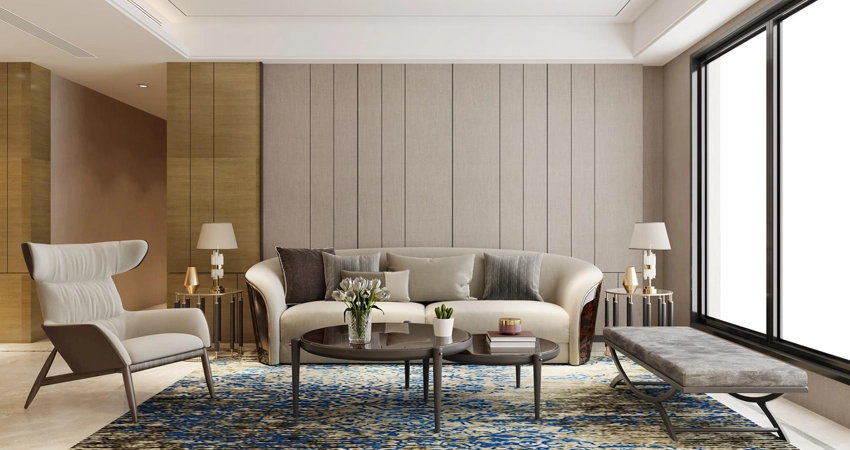Key Takeaways:
- Fake wood paneling offers an authentic look and feel at a fraction of the cost of real wood.
- Durable and resistant to moisture and temperature changes, making it ideal for high-humidity areas.
- Eco-friendly options are available, often made from sustainable and recycled materials.
- A wide variety of styles, finishes, and colors allows customization to match personal aesthetics.
- Proper wall preparation and accurate measurements are crucial for successful installation.
- Common installation mistakes include neglecting acclimation and misjudging panel weight.
- Regular cleaning with mild solutions maintains the beauty of faux wood paneling.
- Minor scratches can be concealed with wood markers or touch-up paint; deeper damage may require repair compounds.
- Faux wood can be used in innovative ways beyond living rooms, such as kitchens, bathrooms, and home offices.
- Combining faux wood with other materials can enhance design aesthetics and create dynamic interiors.
Unveiling the Beauty of Fake Wood Paneling
The Allure of Authenticity: Why Choose Fake Wood?
Fake wood paneling, often referred to as faux wood, has emerged as a popular choice for homeowners and interior designers aiming to create a warm and inviting atmosphere without the hefty price tag associated with real wood. The allure of authenticity is a key factor driving this trend. Faux wood products are crafted using advanced technology that not only mimics the appearance of real wood but also captures its texture and grain patterns. This level of craftsmanship ensures that your space can exude a rustic charm or contemporary elegance akin to solid wood, while also being far more versatile and practical.
One of the most significant advantages of choosing fake wood paneling is its durability. Unlike real wood, which can warp, crack, or split over time, faux wood is engineered to withstand moisture, temperature fluctuations, and everyday wear and tear. This makes it an excellent choice for high-humidity areas such as bathrooms and kitchens. Additionally, fake wood paneling typically requires less maintenance than its natural counterpart, making it ideal for busy households or commercial settings.
Eco-friendliness is another reason to consider faux wood. Many brands manufacture fake wood products using sustainable materials and processes, making them a responsible choice for environmentally conscious consumers. By opting for faux wood, you’re reducing the demand for real timber, thus contributing to forest conservation efforts. Furthermore, recycled materials are often utilized in the manufacturing process, indicating a commitment to sustainability and reduced waste.
Styles and Finishes: Picking the Right Look for Your Space
The expansive array of styles and finishes available in fake wood paneling allows homeowners to customize their spaces to reflect personal tastes and design aesthetics. From traditional shiplap to modern wide planks, the style you choose significantly impacts the overall ambiance of a room. Consider the architectural details of your home when selecting a style, as a farmhouse aesthetic can beautifully contrast with a sleek, contemporary kitchen, creating an inviting focal point.
Texture also plays a crucial role in the selection process. Faux wood paneling comes in various finishes—ranging from matte to glossy—and textures can be smooth, reclaimed, or distressed. Each finish embodies different qualities: for instance, a distressed finish may imbue your space with a sense of history and rustic charm, while a smooth matte surface might reflect a minimalist approach to design. Be mindful of the room’s lighting and its interaction with the chosen finish; light can dramatically alter the perception of color and texture, either enhancing or diminishing these qualities.
Color selection is vital in achieving the desired look. Traditional brown wood tones remain a staple, but the trend is shifting toward greys and whites for a more modern, chic approach. The rise of neutral palettes gives homeowners the flexibility to integrate faux wood paneling seamlessly with various color schemes, making it easier to experiment or refresh decor. Whether you prefer a deep walnut finish for coziness or a light oak for brightness, the myriad of options at your fingertips ensures that every design vision can be realized.
Installation Insights: Elevate Your DIY Game
Prepping Your Walls: Essential Steps Before Installation
Installing fake wood paneling may seem like an overwhelming task; however, with careful planning and preparation, you can create a stunning feature wall or a cozy room transformation. The first step in the installation process is to prepare your walls adequately. Start by ensuring that the surface where you will install the paneling is clean, dry, and flat. Remove any old wallpaper, and patch any holes or imperfections in the drywall to ensure a smooth surface.
Next, take accurate measurements of the wall area to determine how much paneling you will need. This step prevents over-purchasing or running short on material, which can be frustrating during installation. It’s advisable to dry fit the panels before firmly attaching them to the wall. Lay out the panels in the intended arrangement to visualize the final look and make any necessary adjustments. An essential tip during this phase is to mark vertical lines on the wall with a level to guide the alignment of the panels, ensuring each piece is correctly situated.
Another crucial aspect of preparation is to gather your tools and materials ahead of time. You will need a saw for cutting panels, a level, a measuring tape, a pencil for marking, adhesive, and nails or screws depending on the installation method. Having a clean and organized workspace will enhance your efficiency and allow for a smoother installation process.
Common Mistakes to Avoid for a Flawless Finish
A successful installation of fake wood paneling hinges on avoiding common pitfalls that can compromise the overall appearance and longevity of your project. One frequent mistake is neglecting to acclimate the panels before installation. Faux wood panels can expand and contract with temperature changes, so letting them sit in the room where they will be installed for a few days can help minimize future movement and ensure a better fit.
Another common oversight is not accounting for the paneling’s weight. Ensure that the mounting method you choose is appropriate for the weight of the panels, especially if you are installing them on a wall that requires additional reinforcement. Make sure you are using the correct type of adhesive if using glue, as differing materials may require specific adhesives to achieve a strong bond.
Moreover, many DIYers rush through the cutting process to save time. This can lead to uneven edges or misaligned joints, which are often noticeable even after installation. Always take your time with measuring and cutting, and double-check your work to avoid errors. Additionally, ensure adequate spaces for expansion, especially in high-temperature areas, to allow for movement without damaging the panels.
Maintenance Made Easy: Keeping Your Paneling Pristine
Cleaning Hacks: Everyday Solutions for Lasting Beauty
Faux wood paneling is celebrated not just for its aesthetic appeal but also for its easy maintenance compared to authentic wood. Cleaning your panels regularly helps maintain their visual integrity and ensures they continue to enhance the beauty of your space. Start by dusting the panels with a microfiber cloth to remove loose debris. This minor step prevents dirt buildup, which can eventually scratch the surface.
For a more thorough clean, a mixture of warm water and mild dish soap can be effectively used on faux wood surfaces. Avoid harsh chemical cleaners that can damage the finish. Using a soft sponge or cloth, gently wipe down the panels in a circular motion to lift any stubborn stains without risking discoloration or wear. Rinse the cloth and go over the panels once more with clean water to remove any soap residue, which can leave streaks if left to dry.
For tougher stains, such as grease splatters common in kitchens, a gentle abrasive cleaner made from baking soda and water will do wonders. After applying the paste-like consistency over the stain, allow it to sit for a few minutes before gently scrubbing with a soft brush. Additionally, faux wood panels are resistant to moisture, but standing water should still be avoided; dry any spills promptly to preserve the finish and prevent mold growth.
Repairing Scratches and Dents: Quick Fixes that Work
Despite their durability, faux wood panels can occasionally sustain scratches or dents, but worry not; these can often be remedied quickly and effectively. For minor scratches, using a colored wood marker or touch-up paint that matches the paneling can conceal imperfections seamlessly. Simply fill in the scratch with the product, and wipe away any excess for an even finish. This quick fix can drastically improve the appearance of your panels.
For deeper scratches or dents, a repair compound specifically designed for faux wood is recommended. These compounds come in various colors and finishes, allowing you to match your paneling perfectly. Follow the product instructions carefully, as they often involve filling the scratch or dent, allowing it to dry, and then buffing it to blend with the surrounding area effectively.
If your panels have significant damage, such as large dents or holes, replacing the damaged panel may be the best option. Depending on the paneling system used, this process can be straightforward. Cut the affected panel out, ensuring that you follow the original installation pattern, and install a new panel in its place using the appropriate adhesive or fasteners. A well-executed replacement can restore the beauty of your paneling without requiring a complete overhaul of the entire wall.
Transformative Ideas: Where to Use Fake Wood Paneling
Innovative Applications: Beyond the Living Room
Fake wood paneling is not limited to traditional applications such as feature walls in living rooms or bedrooms; its versatility opens the door for countless transformative projects throughout your home. For instance, consider using faux wood paneling in your kitchen. Install it as a backsplash to create a warm, rustic feel that contrasts beautifully with stainless steel appliances and modern cabinetry. This not only adds visual interest but also serves a functional purpose, making it easier to clean up spills and splatters.
Another innovative application is in bathrooms. Faux wood paneling can evoke a spa-like ambiance when used as an accent wall or around the bathtub, lending a touch of nature to an often sterile environment. The moisture-resistant properties of faux wood ensure you don’t have to worry about issues like warping or peeling associated with real wood in humid settings.
Additionally, consider adding faux wood paneling to your home office. Not only does this material help create a cozy, inviting workspace, but it can also function to absorb sound, making for a quieter and more productive environment. Paneling your office can be particularly effective if you frequently take conference calls or work in an open space.
Combining Styles: Blending Fake Wood with Other Materials
The true magic of fake wood paneling lies in its ability to complement a variety of design styles and materials. Combining faux wood with other textures can create a layered, dynamic interior that tells a compelling design story. For example, pairing faux wood paneling with metal accents can evoke a modern-industrial feel that’s both stylish and functional. Think about incorporating metallic light fixtures or decorative items alongside wood-tone wall panels for a cohesive and trendy look.
Incorporating faux wood with stone materials is another creative approach. Consider a stone fireplace paired with faux wood paneling on adjacent walls to create a stunning focal point in your living space. This contrast not only adds depth to the room but also creates a balance between rugged and refined finishes, enhancing the overall aesthetic value.
For those drawn to the minimalist style, a simple fake wood paneling feature can deliver warmth without overwhelming the space. Choose a light finish with sleek lines and minimal embellishments to maintain a clean design while adding character. Mixing faux wood with textiles, such as soft cushions, rugs, and throws, contributes to a comfortable and inviting atmosphere, making your home feel both stylish and lived-in.
As you embark on your design journey with faux wood paneling, remember that the key to striking a harmonious balance lies in exploring a mix-and-match approach. Experimenting with diverse materials alongside your paneling will allow you to create personalized spaces that reflect your individual style while capitalizing on the stunning effects of this versatile material.
FAQ
Question: What types of faux wood paneling are available? – Faux wood paneling comes in various styles, including traditional shiplap, contemporary wide planks, and rustic barn patterns, providing numerous options to match your aesthetic preferences.
Question: Can faux wood paneling be painted or stained? – Yes, faux wood paneling can be painted or stained, allowing for additional customization to achieve your desired look. Make sure to use products compatible with the material for the best results.
Question: Is installation of faux wood paneling a DIY-friendly project? – Absolutely! With proper preparation, accurate measurements, and the right tools, many homeowners find that installing faux wood paneling is a manageable DIY project.
Question: How long does faux wood paneling last? – Depending on the quality and maintenance, faux wood paneling can last many years, often rivaling that of real wood, especially in environments where moisture resistance is a factor.
Question: How does faux wood compare in cost to real wood? – Faux wood paneling is generally much less expensive than real wood, offering a budget-friendly alternative without sacrificing the look and feel of natural wood.
Question: Can faux wood paneling be used outdoors? – While some faux wood products are designed for outdoor use, it is essential to verify the manufacturer’s specifications, as not all faux wood paneling is suitable for exterior applications.
Question: What maintenance do faux wood panels require? – Faux wood panels require minimal maintenance; regular dusting and occasional cleaning with a mild solution will keep them looking pristine without the need for extensive upkeep.
Question: Are there any eco-friendly options for faux wood paneling? – Yes, many manufacturers offer eco-friendly faux wood panels made from sustainable and recycled materials, making them an environmentally conscious choice for interior design projects.
Useful Resources
- HGTV – Home & Garden Television
- Build.com – Home Improvement Products
- Do It Yourself – DIY Information
- Family Handyman – Home Improvement Tips
- Better Homes & Gardens – Home Design Ideas
- Architectural Digest – Architecture & Interior Design
- This Old House – Home Improvement Advice
- Wood Magazine – Woodworking and Projects







